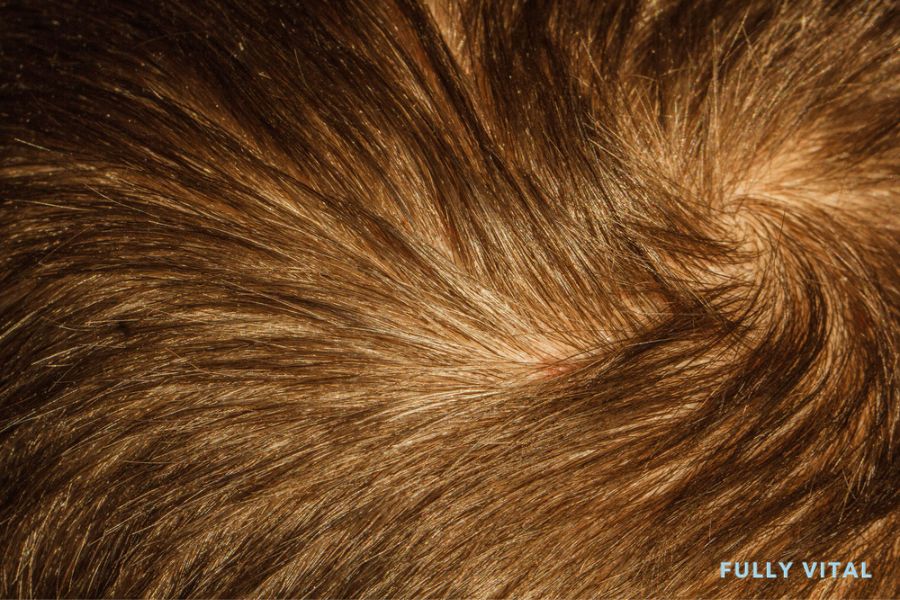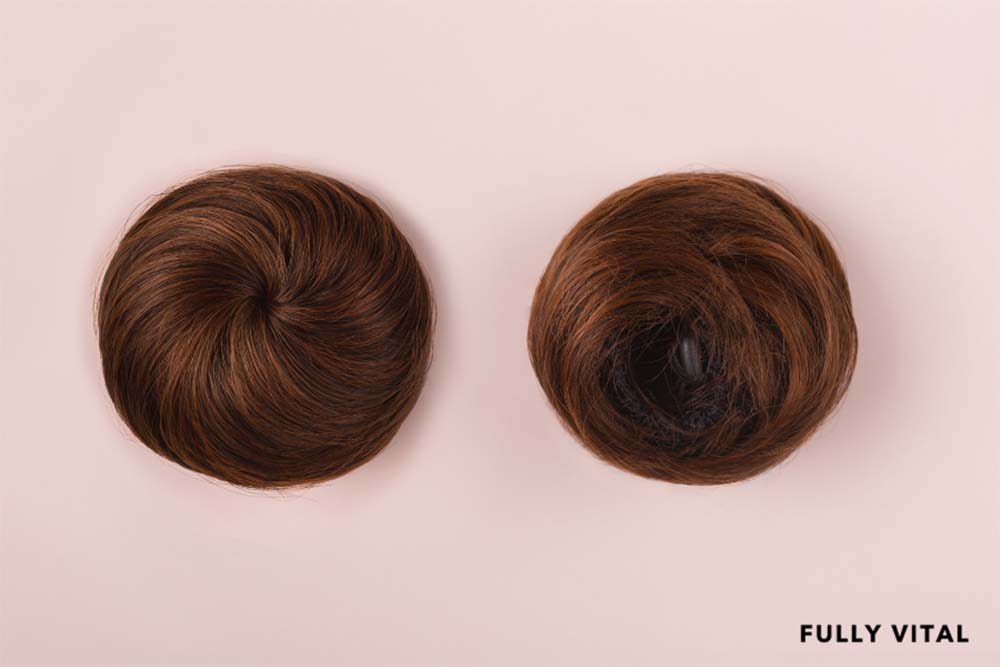
Understanding Hair Whorl: A Key To Hair Growth
Welcome to our comprehensive guide on hair whorl, a fascinating topic that plays a crucial role in your hair growth journey.
Whether you have straight, curly, or wavy hair, understanding your hair whorl is essential for achieving luscious locks.
In this article, we'll delve into the ins and outs of hair whorl, its development, benefits, potential downsides, alternatives, and address frequently asked questions.

I LOVE MY HAIR NOW
FullyVital hair serum and hair vitamins made tremendous improvements in my hair. I truly love my hair now.
Dorit S.,
What Is Hair Whorl?
Hair whorl, also known as a cowlick, is a natural pattern in which your hair grows in a circular or spiral direction at a specific point on your scalp.1
This unique pattern can be clockwise or counterclockwise and is determined by the arrangement of hair follicles.
Each person's hair whorl is as unique as a fingerprint, and it can greatly influence the way your hair behaves.

Why Is Understanding Hair Whorl Important?
Understanding your hair whorl is crucial for several reasons:
Styling
Your hair whorl can affect how your hair falls and styles.
Knowing its location helps you choose the right hairstyles that complement your natural pattern.
Hair Growth
It can impact the direction of hair growth, potentially affecting the thickness and overall appearance of your hair.
Product Selection
When selecting hair growth products, understanding your hair whorl can guide you in choosing the right ones tailored to your specific needs.
How Does Hair Whorl Develop?
Hair whorl develops during fetal development and remains relatively stable throughout your life.
It's influenced by genetics and the positioning of hair follicles on your scalp.
The direction of hair growth is determined by the angle at which hair follicles emerge from the scalp.
What Are The Benefits Of Hair Whorl?
Hair whorl offers several benefits:
- Natural Volume: It can create natural volume and body in your hair, making it easier to style.
- Unique Look: Your hair whorl adds uniqueness to your hairstyle, helping you stand out.
- Healthy Scalp: It may distribute oils from your scalp more evenly, promoting healthier hair.
Are There Any Downsides To Hair Whorl?
While hair whorl has its advantages, it can sometimes pose challenges:
- Styling Challenges: Some people may find it challenging to style their hair due to their hair whorl's direction.
- Cowlicks: Hair whorls can result in stubborn cowlicks that resist styling efforts.
What Are The Alternatives To Hair Whorl?
While you can't change your natural hair whorl pattern, you can work with it or opt for alternative hairstyles that suit your preferences.
Alternatives include:
- Hair Straightening: Using heat tools or chemical treatments to temporarily straighten your hair.
- Hair Extensions: Adding extensions for a different look.
- Haircut Styles: Choosing haircuts that accommodate your natural pattern.
Why Do Hair Whorls Exist?
Hair whorls are a fascinating natural phenomenon that exist for several reasons:
Genetics
The primary factor behind the existence of hair whorls is genetics.
The pattern of hair whorls is determined by the arrangement of hair follicles on your scalp, which is inherited from your parents.2
Fetal Development
Hair whorls develop during fetal development, and their formation is influenced by the growth of hair follicles in a circular or spiral direction.
Scalp Structure
The shape and structure of your scalp also play a role in the formation of hair whorls.
They are often found at specific points on the scalp where hair follicles converge.
Are Hair Whorls Genetic?
Yes, hair whorls are primarily genetic in nature.
They are inherited traits passed down from your parents.
The genes responsible for hair whorls determine the direction and pattern of hair growth on your scalp.
This genetic predisposition is why hair whorls often run in families.
- Inheritance Patterns: If one or both of your parents have hair whorls, there's a high likelihood that you will also have them. The specific location and direction of your hair whorl may vary, but the genetic influence remains consistent.3
- Variations: While genetics play a significant role, there can still be variations in hair whorls among siblings and family members due to the complex interplay of genes.
Do All People Have Hair Whorls?
No, not all people have hair whorls.
Hair whorls are a common but not universal feature.
Their presence or absence varies from person to person and is determined by their genetic predisposition.
Some individuals may have multiple hair whorls, while others may have none.
- Uniqueness: Each person's hair whorl is unique, and its presence or absence contributes to the individuality of their hair and hairstyle.
How Do You Tame A Hair Whorl?
Taming a hair whorl can be achieved with the right techniques and products:
Blow Drying
Use a blow dryer and a round brush to direct the hair in the desired direction as it dries.
This can help train the hair to lie flatter and reduce the appearance of a whorl.
Styling Products
Apply styling products like mousse or pomade to help control the hair and keep it in place.
Haircuts
Opt for hairstyles that work with your natural whorl pattern.
A skilled stylist can recommend a cut that minimizes the appearance of a whorl.
Regular Trims
Regular trims can help maintain the shape and style of your hair, making it easier to manage your whorl.
Can You Get Rid Of A Hair Whorl?
No, you cannot get rid of a hair whorl entirely.
Hair whorls are a natural and permanent feature of your scalp, determined by your genetics and the positioning of hair follicles.
However, you can manage and style your hair to minimize the appearance of a whorl and achieve the look you desire.
- Styling Solutions: Using the right styling techniques and products can help you control and manage your hair whorl.
- Haircuts: Choosing the right haircut can make your whorl less noticeable and work with its natural pattern.
- Acceptance: Embracing your hair's natural characteristics, including your whorl, can lead to unique and attractive hairstyles that suit you.
Unlock The Secret To Youthful Hair With Fully VitalExperience the transformational benefits of Fully Vital's science-backed hair growth products:
Unlock the power of Fully Vital and discover the secret to youthful, radiant hair today! |
Final Thoughts On Hair Whorl
Understanding your hair whorl is not only fascinating but also essential in your journey towards healthier, more vibrant locks.
We've explored the origins of hair whorls, their significance in modern hairstyling, and the exciting possibilities that lie ahead.
At Fully Vital, we're passionate about helping you achieve the best possible relationship with your hair.
Our range of hair growth products is designed to combat the signs of aging, ensuring your locks remain strong and beautiful.
So, whether you're looking to enhance your hair's vitality or seeking solutions to make the most of your unique hair whorl, we're here to support you on your hair care journey.
Discover the benefits of our hair growth products and embrace the beauty of your natural hair with Fully Vital.
Your journey to healthier, more youthful-looking hair starts here.
Frequently Asked Questions About Hair Whorl
Do hair whorls affect hair loss?
Hair whorls themselves don't cause hair loss, but they can influence the direction of hair growth, which may impact the appearance of thinning hair.
Can I change my hair whorl pattern?
Unfortunately, you can't change your natural hair whorl pattern.
It's determined by genetics and your hair follicles' positioning.
Are there specific products for managing cowlicks?
Yes, there are styling products designed to help manage cowlicks caused by hair whorls.
These products can help you achieve your desired hairstyle.
Can I camouflage my hair whorl with certain hairstyles?
Yes, you can choose hairstyles that work with your hair whorl to minimize its visibility or incorporate it into your look.
Are there any health concerns related to hair whorls?
Hair whorls themselves are not a health concern.
However, if you have concerns about your scalp or hair health, it's advisable to consult a dermatologist or trichologist for guidance.
Are hair whorls more common in certain ethnicities?
Hair whorls can be found in people of all ethnic backgrounds.
Their presence or absence is primarily determined by genetics and varies from person to person regardless of ethnicity.
Can hair whorls be a sign of an underlying scalp condition?
Hair whorls are not typically associated with underlying scalp conditions.
However, if you have concerns about your scalp health or notice changes in your hair's appearance, it's advisable to consult a dermatologist or trichologist for a thorough evaluation.
Is there a connection between hair whorls and hair texture?
Hair whorls themselves are not directly linked to hair texture, such as straight, curly, or wavy hair.
Hair texture is determined by the shape of the hair follicle, while hair whorls relate more to the direction of hair growth.
Can you train your hair whorl to grow differently?
You cannot train your hair whorl to grow in a different direction permanently.
It is a natural, genetically determined pattern.
However, you can use hairstyling techniques, products, and haircuts to temporarily influence its appearance.
Do hair whorls change over time?
Hair whorls are relatively stable throughout a person's life.
They are established during fetal development and remain consistent, although the appearance of hair around the whorl may change with age or due to external factors like haircuts and styling choices.
Sources:
- Sechi, A., Neri, I., Patrizi, A., Starace, M., Savoia, F., Leuzzi, M., Caposiena, D., & Bianca Maria Piraccini. (2020). Scalp hair whorl patterns in patients affected by Neurofibromatosis Type 1: A case-control study. International Journal of Trichology, 12(2), 56–56. https://doi.org/10.4103/ijt.ijt_25_20
- Paul, S. P. (2016). Golden Spirals and Scalp Whorls: Nature’s Own Design for Rapid Expansion. PLOS ONE, 11(9), e0162026. https://doi.org/10.1371/journal.pone.0162026
- Rahman, Q., Clarke, K., & Morera, T. (2009). Hair whorl direction and sexual orientation in human males. Behavioral Neuroscience, 123(2), 252–256. https://doi.org/10.1037/a0014816







